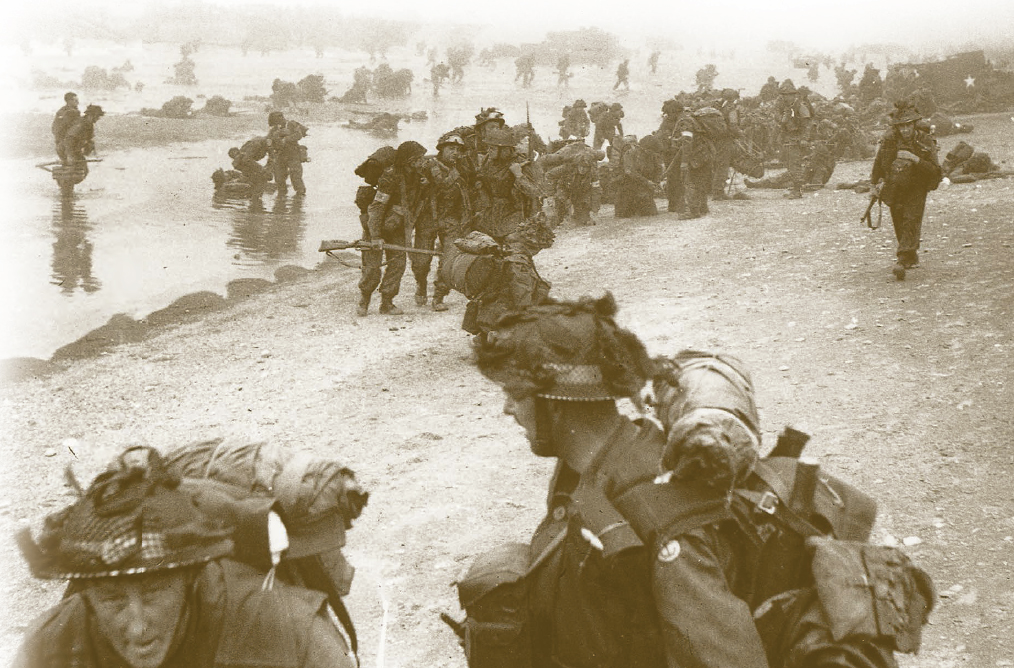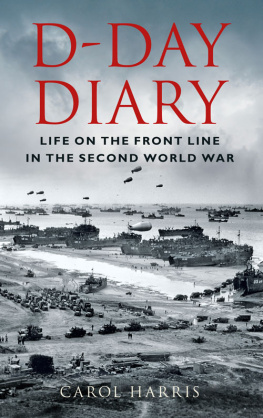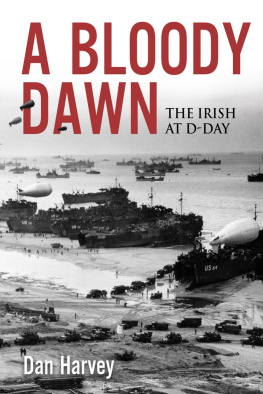
Please visit our website, www.garethstevens.com. For a free color catalog of all our high-quality books, call toll-free 1-800-542-2595 or fax 1-877-542-2596.
Library of Congress Cataloging-in-Publication Data
Samuels, Charlie.
D-Day / by Charlie Samuels.
p. cm. (Turning points in US military history)
Includes index.
ISBN 978-1-4824-0433-3 (pbk.)
ISBN 978-1-4824-3315-9 (6-pack)
ISBN 978-1-4824-0432-6 (library binding)
1. World War, 1939-1945 Campaigns Western Front Juvenile literature. 2. World War, 1939-1945 Campaigns France Normandy Juvenile literature. I. Samuels, Charlie, 1961-. II. Title.
D756.5.N6 S26 2014
940.54dc23
Published in 2014 by
Gareth Stevens Publishing
111 East 14th Street, Suite 349
New York, NY 10003
2014 Brown Bear Books Ltd
For Brown Bear Books Ltd:
Editorial Director: Lindsey Lowe
Managing Editor: Tim Cooke
Childrens Publisher: Anne ODaly
Design Manager: Keith Davis
Designer: Lynne Lennon
Picture Manager: Sophie Mortimer
Production Director: Alastair Gourlay
Picture Credits:
Front Cover: Robert Hunt Library.
All images Robert Hunt Library.
All Artworks Brown Bear Books Ltd
Brown Bear Books has made every attempt to contact the copyright holder. If you have any information please contact
All rights reserved. No part of this book may be reproduced, stored in a retrieval system, or transmitted in any form or by any means, electronic, mechanical, photocopying, recording, or otherwise, without the prior written permission of the copyright holder.
Manufactured in the United States of America
CPSIA compliance information: Batch #CW14GS. For further information contact Gareth Stevens, New York, New York at 1-800-542-2595.
CONTENTS
Introduction
German Mastery of Europe
The United States Enters the War
Allied Plans
German Defenses
Allied Buildup
Setting the Date
Air Landings
Toward the Beaches
Utah Beach
Omaha Beach
Germany Fights Back
Breakout from Normandy
Campaign to the Rhine
Allied Victory
TIMELINE
GLOSSARY
FURTHER INFORMATION
INDEX
INTRODUCTION
B efore dawn on June 6, 1944, the Alliesled by the United States and Britainlaunched Operation Overlord, the biggest amphibious attack in history. By nightfall more than 160,000 men would land on five beaches in Normandy in occupied France. Some landings were straightforward. Others faced fierce resistance from the Germans. But everyone knew that if the Allies could at least get a foothold on mainland Europe, then D-Day would be a turning point in World War II.
Long-Term Strategy
D-Day had been years in the planning. Before it could take place, the Allies had to defeat the Germans in other theaters, to draw men away from northern France. Hundreds of thousands of Allied troops had to be assembled, along with the ships to transport them, vehicles, gas, weapons, and ammunition. The Allied air forces had to gain air superiority over the German Luftwaffe. Resistance fighters in France had to destroy German communications.
The coordination involved was remarkable, and the timing of the operation was in doubt until the last minute. On the evening of June 4, the Allied Supreme Commander, US general Dwight D. Eisenhower, studied the weather forecast and made his decision. D-Day would be June 6, 1944.

This view from a landing craft at Omaha Beach shows US troops wading through the surf from their own landing craft.

British reinforcements land on Sword Beach to support the initial assault groups. The Allied soldiers came ashore in a series of waves.
German Mastery of Europe
Before D-DayJune 6, 1944Germany had controlled most of Europe for nearly three years. At the start of World War II in 1939, its armies rapidly overran its neighbors. Only Great Britain stood between Germany and total domination of the continent. The United States had not yet joined the war, but it sent the British arms and supplies.

German motorcycle troops are on the move in spring 1940. The Germans used vehicles, tanks, and airplanes to make rapid advances.

German Stuka dive-bombers fly in formation to support ground operations. They attacked their targets in a near-vertical dive.
Before 1939 Nazi Germany had used diplomacy to take over Austria and occupy parts of Czechoslovakia. Adolf Hitler, the German leader, had even greater ambitions. On September 1, 1939, Germany invaded Poland. Two days later, Britain and France declared war on Germany. Two weeks later, the Soviet Union also invaded Poland. Germany and the Soviet Union divided the country between themselves.
The Fall of Europe
After a period of inaction known as the phony war, the Nazis invaded Denmark and Norway in April 1940. The next month they took France, Belgium, Luxembourg, and the Netherlands. The British army, which had been sent to protect France, was easily defeated. It had to be rescued from the beaches of Dunkirk.
BLITZKRIEG
Blitzkrieg (lightning war) was a tactic developed by the Germans in the early years of World War II. It relied on rapid advances using Panzer tanks, Stuka dive-bombers, and large numbers of infantry. The Germans stormed through the Low Countries and France in 1940. Once a target was selected, it was bombed from the air and then attacked by tanks and infantry. As the infantry mopped up any remaining resistance, the dive-bombers and Panzers moved straight on to the next target.
Britain Fights On
Britain stood alone. The German air force, the Luftwaffe, bombed British cities, and German submarines (U-boats) attacked convoys carrying supplies across the Atlantic. Hitler planned to invade Britain but was unable to destroy the Royal Air Force (RAF). In fall 1940 he decided to plan the invasion of his former ally, the Soviet Union. The same month, Germany, Italy, and Japan formed an alliance, known as the Axis. In October Germany invaded Romania, and Italy entered Greece.

German tanks parade in front of the Arc de Triomphe in Paris after the fall of the French capital in May 1940.

Firefighters try to save burning buildings during the Blitz, the sustained German bombing campaign against London.
Operation Barbarossa
In early 1941 German troops arrived in North Africa, where their Italian allies were fighting the British, and also invaded Greece. Finally, in June 1941 three million German troops invaded the Soviet Union in what was code-named Operation Barbarossa.
Next page

















